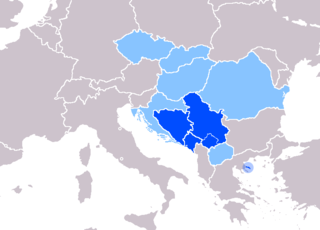
Bijeljina is a city in Bosnia and Herzegovina. It is located in the Republika Srpska entity and is the provincial center of Semberija, a geographic region in the country's northeast. As of 2013, it has a population of 107,715 inhabitants.
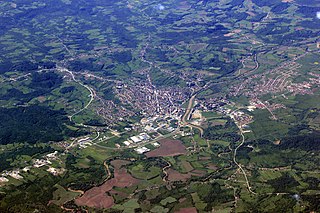
Derventa is a town and municipality located in Republika Srpska, an entity of Bosnia and Herzegovina. It is situated in the Posavina region, northwest of Doboj. As of 2013, the town has a population of 12,680 inhabitants, while the municipality has 27,404 inhabitants.
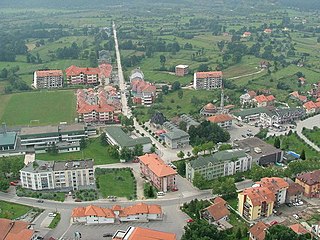
Kalesija is a town and municipality located in Tuzla Canton of the Federation of Bosnia and Herzegovina, an entity of Bosnia and Herzegovina. It is located in northeastern Bosnia and Herzegovina, east of Tuzla. As of 2013, it has a population of 36,478 inhabitants.

Glamoč is a town and municipality located in Canton 10 of the Federation of Bosnia and Herzegovina, an entity of Bosnia and Herzegovina. It is situated in southwestern Bosnia and Herzegovina, at the foot of the hills of Staretina and Velika Golija on the edge of the central part of the Glamoč Field. The municipality encompasses town of Glamoč as a seat of the municipality and more than 50 villages and hamlets situated along the Field. It mainly covers an area of the historical and geographical region of Tropolje.

Milići is a town and a municipality located in Republika Srpska, an entity of Bosnia and Herzegovina. As of 2013, it has a population of 11,441 inhabitants.

Prnjavor is a town and municipality located in Republika Srpska, an entity of Bosnia and Herzegovina. As of 2013, it has a population of 35,956 inhabitants.
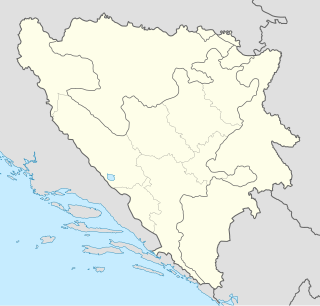
Operation Corridor 92 was the largest operation conducted during the Bosnian War by the Army of Republika Srpska (VRS) against the forces of the Croatian Defence Council (HVO) and the Croatian Army (HV) in the Bosanska Posavina region of northern Bosnia and Herzegovina between 24 June and 6 October 1992. The objective of the offensive was to re-establish a road link between the city of Banja Luka in the west of the country and the eastern parts of the territory controlled by the Bosnian Serbs. The offensive was prompted by the capture of Derventa by the HV and the HVO – a move that blocked the single overland road between the VRS-controlled territories.

Brezici is a village in the municipality of Derventa, Bosnia and Herzegovina.

Bukovica Velika is a village in the municipality of Derventa, Bosnia and Herzegovina.

Donja Bišnja is a village in the municipality of Derventa, Bosnia and Herzegovina.

Tetima is a village in the municipality of Derventa, Bosnia and Herzegovina.

Vrhovi is a village in the municipality of Derventa, Bosnia and Herzegovina.

The Church of Saint Elias is a Roman Catholic church in Glamoč, Bosnia and Herzegovina.
The Veselinje Monastery is a Serbian Orthodox monastery dedicated to John the Baptist and located at the village of Vrba 5 kilometres south-east of the town of Glamoč, in western Bosnia and Herzegovina. The monastery's church, consecrated on 10 August 1975, was built without intention to found a monastery around it. The ktitor of the church was Veselin Nearlović, a businessman from Buenos Aires, Argentina, who was born in Vrba. After the ktitor agreed with the idea to establish a monastery at the church, monastic buildings were constructed, and the Veselinje Monastery was consecrated on 8 April 1985.

The Vozuća Monastery is a Serbian Orthodox monastery dedicated to the Holy Trinity and located around 5 kilometres from the village of Vozuća in the Municipality of Zavidovići, central Bosnia and Herzegovina. The monastery was first mentioned in 1617, though it was probably founded in the 16th century. After it was abandoned in 1690, during the Great Turkish War, it remained empty for more than a century. It was renovated two times during the 19th century, between 1856 and 1859, and in 1884. An elementary school was constructed at the monastery in 1858, but it was closed in 1894. That year, a wooden bell tower was built beside the monastery's church.
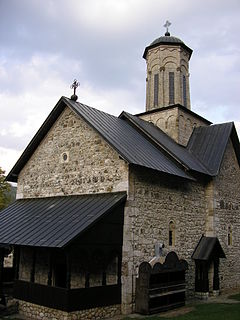
The Liplje Monastery is a Serbian Orthodox monastery dedicated to the Annunciation and located in the Municipality of Teslić in northern Republika Srpska, Bosnia and Herzegovina. It stands at the widest part of a narrow gorge through which a little river named Bistrica flows. The earliest mention of the monastery is found in a chronicle dated to the second half of the 15th century. During the 17th century, the monks of Liplje were active in transcribing religious books.

The Church of Saint George, Sopotnica is a Serbian Orthodox church located at the village of Sopotnica in the Municipality of Novo Goražde in eastern Republika Srpska, Bosnia and Herzegovina. The church stands at the left bank of the Drina River, 4 kilometres from the town of Goražde. It was built in 1454 by Stefan Vukčić Kosača, when Goražde was part of a region ruled by him. The region would later come to be known as Herzegovina, after Kosača's title Herceg of Saint Sava. Herzegovina was gradually conquered by the Ottoman Empire between 1465 and 1481.

The Battle of Orašje was fought during the Bosnian War, from 5 May to 10 June 1995, between the Bosnian Serb Army of Republika Srpska and the Bosnian Croat Croatian Defence Council for control of the town of Orašje and its surrounding area on the south bank of the Sava River. The offensive codenamed Operation Flame-95 and referred to by Croatian sources as Operation Revenge was actually fought with varying intensity, with periods of combat interspersed by lulls lasting two to seven days. The heaviest fighting was reported on 15 May, when the VRS managed to break through a portion of the HVO defences near the village of Vidovice, but the breach was successfully contained and the lost ground was recovered by the HVO.
Plehan is the hill about 315 meters high in Bosnia and Herzegovina 9 km southeast of town Derventa. It is famous by a catholic parish of the same name, one of the oldest in the area dating from the Middle Ages. In 19th century Franciscans built monastery and later they added new church. It had a rich library and museum and it became site of pilgrimage and public gathering place for many Croats living in Derventa’s county. During the war in Bosnia and Herzegovina in 1992 the church and monastery were demolished by Serb military forces, some of the new structures began to be rebuilt in 2001.
